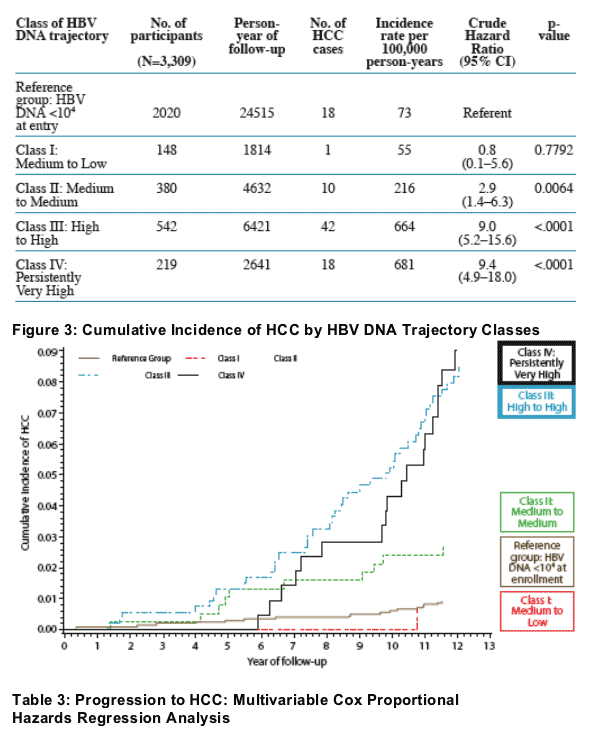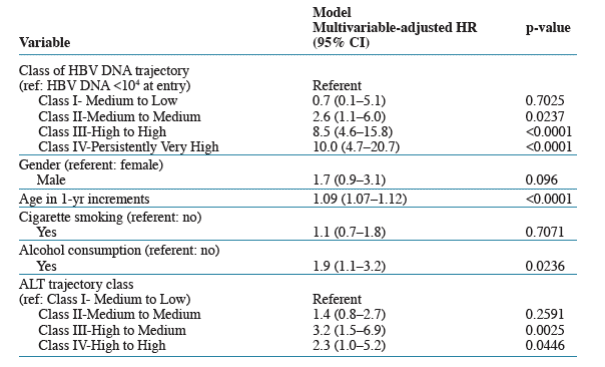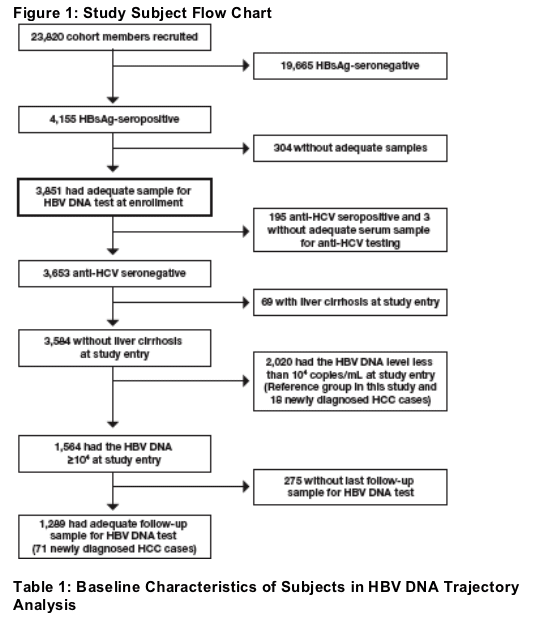 |
 |
 |
| |
Changes in Serum HBV DNA Level Using a Trajectory Model to Predict the
Risk of HCC in Chronic Hepatitis B Patients: The R.E.V.E.A.L.-HBV Study
|
| |
| |
Reported by Jules Levin
AASLD, Nov 2-6, 2007, Boston, MA
Chuen-Fei Chen1,2, Hwai-I Yang1,2, Uchenna H Iloeje3, Jun Su3, Chin-Lan Jen1,2, San-Lin You1,2, Chien-Jen Chen1,2, for The R.E.V.E.A.L.-HBV Study Group
1Genomics Research Center, Academia Sinica, Taipei, Taiwan; 2Graduate Institute of Epidemiology, College of Public Health, National Taiwan University, Taipei, Taiwan; 3Global Epidemiology and Outcomes Research, Research and Development, Bristol-Myers Squibb Co, Wallingford, CT, USA
Introduction
The risk of disease progression in chronic hepatitis B (CHB) is linked to several viral, biochemical, and immunologic markers
In our published analyses,1, 2 baseline serum HBV DNA was a predictor of liver cirrhosis and hepatocellular carcinoma (HCC)
Elevated serum HBV DNA level is a strong risk predictor of developing HCC in CHB patients
The study aims were investigated using latent trajectory classes of serum HBV DNA changes over time in the Risk Evaluation of Viral Load Elevation and Associated Liver Disease/Cancer (R.E.V.E.A.L.)-HBV study cohort (interim analysis)
- To evaluate the relationship between HBV DNA viral load changes
over time and HCC risk
Author Summary
Describing HBV DNA trajectories over time:
- Four classes of serum HBV DNA trajectories were identified by
the model
- The majority of the study subjects were in Classes II, III, and IV and had serum HBV DNA ≥300 copies/mL at study entry and remained there throughout follow-up
Serum HBV DNA change and incidence/risk of progressing to HCC:
- The incidence of HCC increased with serum HBV DNA trajectory class (reference subjects HBV DNA <104 copies/mL)
- In the Cox proportional hazards model, change in serum HBV DNA as measured by the serum HBV DNA trajectory class was a strong predictor of HCC risk
- High serum ALT level over time was a risk predictor of HCC progression even after adjusting for HBV DNA trajectory classes
Author Conclusions
Risk stratification for HCC and liver disease complications is possible using models comprised of readily available non-invasive clinical information
Serum HBV DNA level over time is a strong predictor of HCC, independent of gender, age, cigarette smoking, alcohol consumption and ALT trajectory



Methods
The R.E.V.E.A.L.-HBV study is a population-based prospective cohort study with a mean follow-up of 11.4 years as previously described in the published analysis2
A subgroup of this study cohort contributed to these analyses (HBsAg-seropositive and anti-HCV-seronegative, without liver cirrhosis at entry)
There were 1,289 participants with HBV DNA ≥10,000 copies/mL at entry with ≥2 HBV DNA measurements included in this analysis
The other 2,020 participants with HBV DNA <104 copies/mL at entry were analyzed as the reference group
HBV DNA levels were defined as:
- Low: HBV DNA <300 copies/mL
- Medium: HBV DNA ≥300 copies/mL but <100,000 copies/mL
- High: HBV DNA ≥100,000 copies/mL but <1 million copies/mL
- Very high: HBV DNA ≥10 million copies/mL
Trajectory models were classed by baseline and follow-up HBV DNA
levels:
- Class I: Medium to Low
- Class II: Medium to Medium
- Class III: High to High
- Class IV: Persistently Very High
Laboratory analyses:
- HBV DNA serum samples by PCR (Roche Diagnostics Co., Indianapolis, IN)
- HBsAg and HBeAg by radioimmunoassay (Abbott Laboratories, North Chicago, IL)
- Anti-HCV antibody by second generation ELISA kits (Abbott Laboratories, North Chicago, IL)
- ALT by serum chemistry autoanalyzer (Model 736, Hitachi Co., Tokyo Japan) using commercial reagents (bioMérieux, Mercy-l'Etoile, France)
Analyses:
- Semi-parametric group-based modeling was used to determine major trajectory classes of HBV DNA and ALT
- Cox proportional hazards modeling was used to analyze associations between HBV DNA trajectory classes and progression to HCC
- The statistical software SAS (SAS Institute Inc., Cary, NC) was used to obtain the corresponding estimates and figures


References
1. Iloeje U, Yang HI, Su J, et al. Predicting cirrhosis risk based on the level of circulating hepatitis B viral load . Gastroenterology. 2006;130(3):678-86
2. Chen CJ, Yang HI, Su J, et al. Risk of hepatocellular carcinoma across a biological gradient of serum hepatitis B virus DNA level. JAMA. 2006;295(1):65-73
|
| |
|
 |
 |
|
|